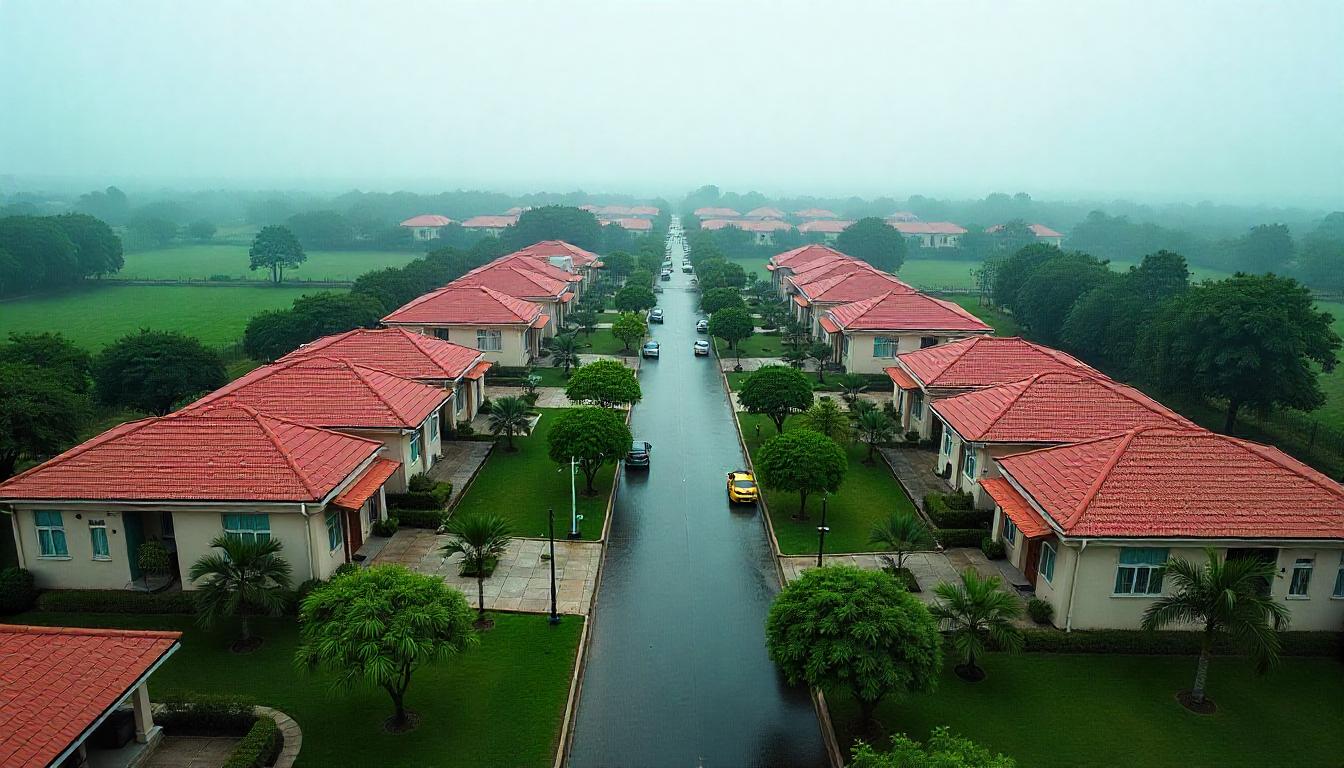
Blog
We keep you up to date on the most recent real estate news and events.
The Panchkula Shift: Why North India’s Homebuyers Are Looking Beyond Metros
Why Panchkula is North India’s New Haven for Aspirational Living
In 2024, homebuyers in North India are rethinking their priorities. The allure of metropolitan cities like Delhi, Gurgaon, and Noida—once synonymous with opportunity and growth—is fading under the weight of urban fatigue. According to JLL’s India Residential Market Dynamics Q4 2024, over 50% of residential sales in India’s top cities in 2024 were in the ₹1 crore+ (mid-premium to luxury) segment—underscoring a substantial shift toward homes offering enhanced lifestyle features, greater comfort, and wellness orientation. The post-COVID era has intensified a desire for space, cleaner air, and a slower pace of life, prompting buyers to seek out well-planned, nature-centric cities like Panchkula.
Panchkula, nestled at the foothills of the Shivalik hills, is emerging as North India’s answer to this growing demand for balanced living. With property prices in Delhi-NCR surging by 30% in 2024—from ₹5,800 per sq. ft. in 2023 to ₹7,550 per sq. ft.—and similar spikes in Gurgaon and Noida, buyers are seeking alternatives that offer value without compromising lifestyle. Panchkula, with its blend of modern infrastructure, natural beauty, and affordability, is fast becoming a magnet for high-net-worth individuals (HNIs), non-resident Indians (NRIs), and first-time buyers alike.
This blog explores why Panchkula is redefining North India’s real estate landscape and the evolving mindset of modern homebuyers.
The Challenges of Metro Living and Why Buyers Are Looking Elsewhere
Life in North India’s Tier-1 cities has become a paradox. While Delhi, Gurgaon, and Noida remain economic powerhouses, they struggle with overcrowding, pollution, and skyrocketing costs. In 2024, Delhi’s air quality frequently crossed the ‘severe’ threshold, with AQI often above 400—making it one of the world’s most polluted capitals.
Traffic congestion is another chronic challenge: According to the TomTom Traffic Index 2023, New Delhi ranked 44th globally among 387 cities in terms of urban traffic congestion.
On average, commuters spent 21 minutes and 40 seconds driving 10 km—a 48% congestion level. Rush-hour travel added approximately 76 hours of delay annually, compared to free-flow conditions.
The cost of living in these metros is equally daunting. Anarock reports that Gurgaon’s luxury housing segment, particularly in areas like Golf Course Road, saw prices soar to ₹18,000–₹22,000 per sq. ft. in 2024, pricing out many middle-class buyers. Space constraints further exacerbate the issue—average flat sizes in the Delhi-NCR region have shrunk by 8% over the past five years, as developers have prioritized high-density projects to maximize returns. For families seeking larger homes with green spaces, these cities are increasingly unattainable.
Urban fatigue is clearly on the rise. This growing disillusionment is fueling migration to cities like Panchkula, where buyers can enjoy modern amenities, cleaner air, and less stress without the prohibitive costs of Tier-1 metros.
Why Panchkula? A City Built for the Future
Panchkula stands out as a beacon of planned urban living. Located in Haryana, it benefits from its strategic position near Chandigarh, Mohali, and Zirakpur, offering seamless connectivity while maintaining a serene, low-density environment. Here’s why Panchkula is capturing the imagination of North India’s homebuyers:
Geographic Advantage
Nestled against the Shivalik hills and surrounded by lush forests, Panchkula offers a rare blend of natural beauty and urban convenience. Its proximity to Himachal Pradesh makes it a gateway to weekend retreats in the hills, while its location just 10 kilometres from Chandigarh ensures access to a cosmopolitan hub. Unlike Delhi’s smog-laden winters, Panchkula boasts an AQI averaging 50–100, classified as ‘good’ to ‘moderate’ for most of the year, making it a haven for wellness-conscious buyers.
Planned Infrastructure
Panchkula’s urban planning is a masterclass in foresight. Designed as an extension of Chandigarh’s grid-based layout, the city features wide roads, low congestion, and well-maintained public spaces. The Haryana government’s investment in infrastructure, including the upcoming Panchkula-Morni road expansion, enhances connectivity to nearby tourist destinations. The city’s master plan prioritises green cover, with 40% of its area dedicated to parks, forests, and open spaces, according to the Haryana Urban Development Authority.
Livability Metrics
With declining crime rates and robust civic infrastructure, Panchkula offers a safe and well-connected lifestyle. The Tribune notes a consistent drop in key crimes in 2024, reinforcing the city’s reputation for livability. Property prices, while rising, remain competitive: Anarock notes that average residential prices in Panchkula hovered around ₹5,500–₹7,000 per sq. ft. in 2024, significantly lower than Gurugram's ₹12,000–₹18,000 per sq. ft. Affordable land costs have also spurred the development of premium integrated townships, offering a lifestyle comparable to metro cities at a fraction of the cost.
Real Estate Trends: Panchkula’s Ascent
Panchkula’s real estate market is witnessing a quiet revolution. While Delhi-NCR and Mumbai dominate headlines, peripheral cities like Panchkula are seeing higher price appreciation potential.
According to ANAROCK, peripheral micro-markets in India outperformed metro areas, recording up to 69% price growth between 2019 and 2024, compared to 40–60% in prime metro zones. In Panchkula, residential prices rose from around ₹5,000–7,500 per sq ft to ₹6,200–8,500 per sq ft over a five-year period, marking a 25–30% increase, driven by demand for premium and luxury homes.
Rise of Integrated Townships
The rise of integrated townships—self-contained communities featuring homes, schools, healthcare facilities, and leisure spaces—is reshaping Panchkula’s real estate landscape. Projects like Trident Hills exemplify this trend, offering plotted developments and premium floors with amenities like wellness centres, clubhouses, and green spaces. These townships cater to buyers seeking a balanced, nature-led lifestyle. According to JLL’s Q4 2024 report, over 50% of residential sales in major cities were in the ₹1 crore+ segment, reflecting growing demand for mid-premium and luxury housing—momentum that Panchkula is increasingly tapping into.
Investor Interest
Investor interest in residential real estate is gaining momentum, with Tier‑2 cities like Panchkula poised to benefit. Knight Frank’s Trends in Private Equity Investment in India 2024 report shows that private equity investments in Indian real estate rose 32% in 2024 to US $4.15 billion, with the residential sector accounting for 28% of these inflows (about US $1.18 billion). This surge underscores growing institutional confidence not just in metros but also in emerging markets. Panchkula’s strategic connectivity to Chandigarh, rising infrastructure, and competitive pricing make it an attractive option for both HNIs and NRIs.
Connectivity & Social Infrastructure: The Backbone of Growth
Panchkula’s appeal lies in its balance of connectivity and quality of life. The city is a 15-minute drive from Chandigarh International Airport and is well-connected to Delhi via NH-44, with travel time reduced to 3.5 hours after recent highway upgrades. The upcoming Chandigarh Metro extension, set to include Panchkula by 2027, will further boost accessibility.
Social infrastructure is another draw. Panchkula is home to top-tier schools like The Gurukul and St. Xavier’s, hospitals like Alchemist and Paras, and shopping destinations like Elante Mall in nearby Chandigarh. The city’s leisure offerings, including the Yadavindra Gardens and Morni Hills, cater to families seeking a blend of urban and outdoor lifestyles. According to CBRE’s 2023 “Tier-II Cities: Coming of Age” report, quality social infrastructure such as healthcare, education, and recreational spaces is a critical factor driving residential demand in emerging cities, with buyers increasingly favouring well-rounded urban ecosystems like Panchkula.
The New Buyer Mindset: Wellness and Community
The modern Indian homebuyer is no longer swayed solely by proximity to offices. According to JLL’s 2024 Consumer Experience Survey, 88% of people consider access to green spaces as a key factor when selecting where to live, ranking it higher than many traditional amenities. This shift highlights a broader trend toward nature-integrated, health-focused environments, with demand increasing for developments that incorporate parks, open spaces, and community-oriented areas.
Panchkula aligns perfectly with this shift. Developments like Trident Hills offer yoga pavilions, jogging tracks, and landscaped gardens, appealing to buyers who value health and community. First-time buyers, retirees, and NRIs are particularly drawn to Panchkula’s value proposition. For instance, a 3BHK villa in a premium township costs ₹1.5–2 crore, compared to ₹3–5 crore for a similar property in Gurugram. The city’s low-density living also resonates with retirees seeking peaceful environments and families prioritising safety and space for children.
Future Outlook: Panchkula as a Next-Generation City
Panchkula’s trajectory is upward. The Haryana government’s focus on sustainable urbanisation, coupled with private investments in real estate, positions the city as a future-ready destination. The Economic Survey 2024-25 highlights that infrastructure development, including roads and metro networks, is driving real estate demand in Tier-2 cities like Panchkula. Projects like Trident Hills are setting new benchmarks, offering smart homes with eco-friendly features such as rainwater harvesting and solar panels, which align with the growing demand for sustainable living. The city’s ability to balance affordability, connectivity, and lifestyle makes it a compelling choice for aspirational buyers seeking a more serene environment beyond the chaos of metropolitan areas.
Conclusion - The Panchkula Advantage
As North India’s homebuyers grapple with the challenges of metro living, cities like Panchkula offer a refreshing alternative: planned urbanisation, natural beauty, and a community-centric ethos. Real estate demand is shifting from congested metros to smaller towns, thanks to rapid urbanisation, improved connectivity, and lifestyle-driven preferences—cities such as Panchkula are benefitting,” according to ET Now Real Estate Insights, referencing the Anarock‑FICCI Homebuyer Sentiment Survey 2024.
For investors and homebuyers, the message is clear: Panchkula is no longer a peripheral player. It’s a city poised to redefine North India’s real estate landscape, offering a rare blend of value, serenity, and future-ready growth